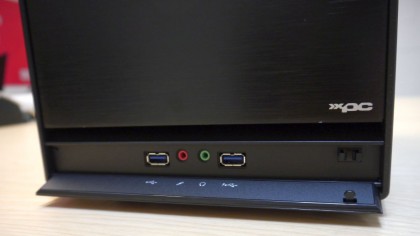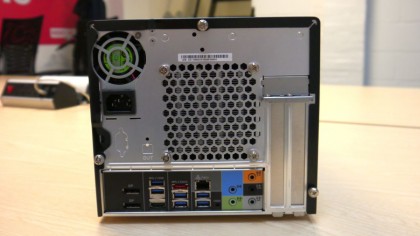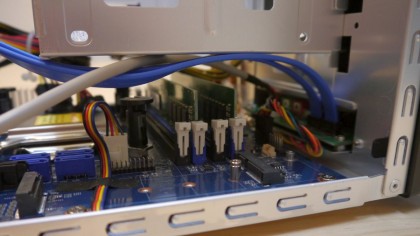Early Verdict
This is an impressive barebones system which is really nicely designed and can pack some powerful components.
Pros
- +
Great design and easy access to innards
- +
Nicely meaty PSU
- +
Impressive connectivity
- +
Premium build quality
Cons
- -
U-shaped cover isn't ideal
- -
Not cheap
Why you can trust TechRadar
The last few years have seen a variety of form factors emerging. However, it's easy to forget that vendors have been trying to break away from the mould (the beige mid-tower format) for ages. One of the first was a Taiwanese manufacturer called Shuttle which pioneered small form factor cubes for ages. You will need a pair of them to fill an average mid-tower case and you don't lose any of the functionality or upgrade capabilities.
The Shuttle SZ170R8 cuts a very familiar shape, reminding us of the XPC SX38P2 Pro and the SH55J2 amongst others – it has a similar rectangular shaped chassis with a square-ish fascia. Since it is a barebones model, it comes without a processor, system memory or storage.

It is available at Ballicom for about £286 (around $420, AU$580) all inclusive which is a lot for what is essentially a pretty case, motherboard and a custom fan. Shuttle aims it at the DIY enthusiast who may use it for a microserver, a portable gaming rig or even a home theatre PC (HTPC).
The front panel is essentially a brushed aluminium, anodised black panel with a couple of LEDs (activity, power) and the power button. At the bottom is a flap that hides two audio ports and two USB 3.0 ports. Note that it doesn't have an SD card reader.
There are plenty of holes on either side of the unit to facilitate air circulation, which is vital if you want to keep your system cool under load. Empty, it weighs around 3.5kg with a 14.2 litre volume.

Visible at the back of the device are the fan outlet (a 60mm unit) for the proprietary power supply unit and the air outlet for the processor heatsink fan plus a myriad of ports. There are six USB 3.0 ports, two DisplayPorts, an eSATA and HDMI connectors, a GbE LAN port, a CMOS reset button and 7.1 audio.
This means that Shuttle's little box will be able to drive two 4K monitors if required. Opening the chassis requires unscrewing three thumb screws and removing the U-shaped cover (which reminded us of how entry-level cases were in the distant past).
Sign up to the TechRadar Pro newsletter to get all the top news, opinion, features and guidance your business needs to succeed!

There's plenty of space inside, partly because the PSU is so small (and yet it is a 500W model with an 80% plus efficiency). The SZ170R8 can take up to four 3.5-inch hard disk drives (up to 40TB) with four expansion slots available (PCI-e x16, PCI-e x4, M.2 and Mini PCI-e) and four memory slots (supporting up to 64GB DDR4-2133 RAM modules).
The chassis will support dual-slot graphics cards, like the AMD R9 Nano, complete with a 6-pin connector, up to a size of 267 x 120 x 34.6mm.

Access to all the empty ports and the drive cage is pretty straightforward and the same is true when it comes to removing the CPU heatsink and fan. Underneath it is a Socket LGA 1151, which paired with the Z180 chipset, supports Skylake CPUs with a TDP of up to 95W. Note that Intel Xeon E3 v5 processors are not compatible.
The cooler uses Shuttle's signature ICE (Integrated Cooling Engine) technology with three pipes and a temperature controlled 92mm fan with noise reduction technology.

What surprised us was how easy it was to access the ports and empty bays. Sure, there are loads of cables and it was a touch tricky at times, but this is where Shuttle's two decades of expertise come to light, both as a case and a motherboard manufacturer.
Early verdict
A loaded SZ170R8 will have an Intel Core i7 processor at its heart, 64GB of RAM, up to eight SSDs (or four HDDs) and a dual-slot GPU. This spec will compete with ease when compared to much bigger desktop counterparts and the 500W power supply unit has the necessary firepower to handle all these components comfortably.
This is not, therefore, your usual barebones system – it bears all the hallmarks of one that has been fine-tuned for the connoisseur who will look to build a powerful and yet portable gaming rig or workstation that can crunch vast amounts of data.
The SZ170R8 felt premium despite the U-shaped cover, which we were not a big fan of. It is expensive but in the grander scheme of things, will only account for a fraction of what you'd expect to pay for a decent gaming base unit.
When a branded full-size gaming case with a quality power supply unit and a decent cooling solution costs a couple of hundred pounds, it doesn't feel ludicrous to spend a bit more to save on space.
The real competition though doesn't come from other vendors; there's barely anyone left in this space. Shuttle operates in a niche but lucrative market, one that has seen gaming laptops, like the Dell Inspiron 15 7000, emerge as realistic alternatives for gamers on the move.
Outside gaming though, this unit will shine as a more elegant and nimbler alternative to your standard workstation rig. The fact that you can slot in a top-end graphics card (Nvidia Quadro or AMD FirePro) makes it an interesting candidate for all sorts of exotic applications.
- Also check out: 10 best desktop PCs 2016: which computer should you buy?

Désiré has been musing and writing about technology during a career spanning four decades. He dabbled in website builders and web hosting when DHTML and frames were in vogue and started narrating about the impact of technology on society just before the start of the Y2K hysteria at the turn of the last millennium.
What is a hands on review?
Hands on reviews' are a journalist's first impressions of a piece of kit based on spending some time with it. It may be just a few moments, or a few hours. The important thing is we have been able to play with it ourselves and can give you some sense of what it's like to use, even if it's only an embryonic view. For more information, see TechRadar's Reviews Guarantee.
